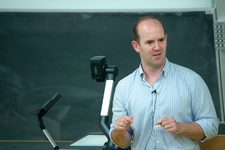Eben Upton of Raspberry Pi
Meet the Baker

© CC BY-SA 2.0 jimkillock
After six years of development, founder Eben Upton and the other members of the Raspberry Pi Foundation are finally seeing the results of their efforts.
Launched on February 29, 2012, the Raspberry Pi, a computer the size of a credit card (Figure 1), has become one of free software's success stories. Despite the difficulties of manufacturing – there was briefly a limit of one per customer – the Pi, as it is popularly called, has sold nearly 900,000 copies and could easily sell a million by its first anniversary. "It's completely incredible," says founder Eben Upton, of all that has happened.
Now 34, Upton [1] has been programming since he was 10 years old, starting with early computers like the BBC Microcomputer, the Commodore, and the Amiga. As an adult, he has been a member of the University of Cambridge's Computer Laboratory, the founder of Ideaworks Game Studio, and most recently, a chip engineer.
For much of his life, he has been a free software user and enthusiast, but before Raspberry Pi, his main contribution to free software was with BlueCove [2], a JSR-82 J2SE implementation to communicate with Bluetooth on OS X and Windows.
[...]
Buy this article as PDF
(incl. VAT)
Buy Linux Magazine
Subscribe to our Linux Newsletters
Find Linux and Open Source Jobs
Subscribe to our ADMIN Newsletters
Support Our Work
Linux Magazine content is made possible with support from readers like you. Please consider contributing when you’ve found an article to be beneficial.

News
-
Two New Distros Adopt Enlightenment
MX Moksha and AV Linux 25 join ranks with Bodhi Linux and embrace the Enlightenment desktop.
-
Solus Linux 4.8 Removes Python 2
Solus Linux 4.8 has been released with the latest Linux kernel, updated desktops, and a key removal.
-
Zorin OS 18 Hits over a Million Downloads
If you doubt Linux isn't gaining popularity, you only have to look at Zorin OS's download numbers.
-
TUXEDO Computers Scraps Snapdragon X1E-Based Laptop
Due to issues with a Snapdragon CPU, TUXEDO Computers has cancelled its plans to release a laptop based on this elite hardware.
-
Debian Unleashes Debian Libre Live
Debian Libre Live keeps your machine free of proprietary software.
-
Valve Announces Pending Release of Steam Machine
Shout it to the heavens: Steam Machine, powered by Linux, is set to arrive in 2026.
-
Happy Birthday, ADMIN Magazine!
ADMIN is celebrating its 15th anniversary with issue #90.
-
Another Linux Malware Discovered
Russian hackers use Hyper-V to hide malware within Linux virtual machines.
-
TUXEDO Computers Announces a New InfinityBook
TUXEDO Computers is at it again with a new InfinityBook that will meet your professional and gaming needs.
-
SUSE Dives into the Agentic AI Pool
SUSE becomes the first open source company to adopt agentic AI with SUSE Enterprise Linux 16.

